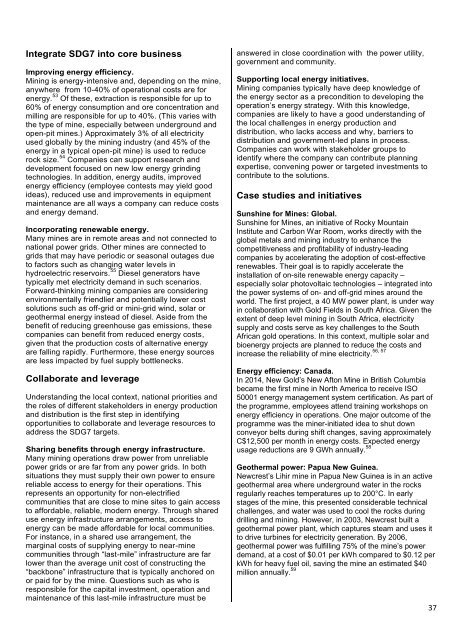Mapping Mining to the Sustainable Development Goals An Atlas
2gpArJN
2gpArJN
Create successful ePaper yourself
Turn your PDF publications into a flip-book with our unique Google optimized e-Paper software.
Integrate SDG7 in<strong>to</strong> core business<br />
Improving energy efficiency.<br />
<strong>Mining</strong> is energy-intensive and, depending on <strong>the</strong> mine,<br />
anywhere from 10-40% of operational costs are for<br />
energy. 53 Of <strong>the</strong>se, extraction is responsible for up <strong>to</strong><br />
60% of energy consumption and ore concentration and<br />
milling are responsible for up <strong>to</strong> 40%. (This varies with<br />
<strong>the</strong> type of mine, especially between underground and<br />
open-pit mines.) Approximately 3% of all electricity<br />
used globally by <strong>the</strong> mining industry (and 45% of <strong>the</strong><br />
energy in a typical open-pit mine) is used <strong>to</strong> reduce<br />
rock size. 54 Companies can support research and<br />
development focused on new low energy grinding<br />
technologies. In addition, energy audits, improved<br />
energy efficiency (employee contests may yield good<br />
ideas), reduced use and improvements in equipment<br />
maintenance are all ways a company can reduce costs<br />
and energy demand.<br />
Incorporating renewable energy.<br />
Many mines are in remote areas and not connected <strong>to</strong><br />
national power grids. O<strong>the</strong>r mines are connected <strong>to</strong><br />
grids that may have periodic or seasonal outages due<br />
<strong>to</strong> fac<strong>to</strong>rs such as changing water levels in<br />
hydroelectric reservoirs. 55 Diesel genera<strong>to</strong>rs have<br />
typically met electricity demand in such scenarios.<br />
Forward-thinking mining companies are considering<br />
environmentally friendlier and potentially lower cost<br />
solutions such as off-grid or mini-grid wind, solar or<br />
geo<strong>the</strong>rmal energy instead of diesel. Aside from <strong>the</strong><br />
benefit of reducing greenhouse gas emissions, <strong>the</strong>se<br />
companies can benefit from reduced energy costs,<br />
given that <strong>the</strong> production costs of alternative energy<br />
are falling rapidly. Fur<strong>the</strong>rmore, <strong>the</strong>se energy sources<br />
are less impacted by fuel supply bottlenecks.<br />
Collaborate and leverage<br />
Understanding <strong>the</strong> local context, national priorities and<br />
<strong>the</strong> roles of different stakeholders in energy production<br />
and distribution is <strong>the</strong> first step in identifying<br />
opportunities <strong>to</strong> collaborate and leverage resources <strong>to</strong><br />
address <strong>the</strong> SDG7 targets.<br />
Sharing benefits through energy infrastructure.<br />
Many mining operations draw power from unreliable<br />
power grids or are far from any power grids. In both<br />
situations <strong>the</strong>y must supply <strong>the</strong>ir own power <strong>to</strong> ensure<br />
reliable access <strong>to</strong> energy for <strong>the</strong>ir operations. This<br />
represents an opportunity for non-electrified<br />
communities that are close <strong>to</strong> mine sites <strong>to</strong> gain access<br />
<strong>to</strong> affordable, reliable, modern energy. Through shared<br />
use energy infrastructure arrangements, access <strong>to</strong><br />
energy can be made affordable for local communities.<br />
For instance, in a shared use arrangement, <strong>the</strong><br />
marginal costs of supplying energy <strong>to</strong> near-mine<br />
communities through “last-mile” infrastructure are far<br />
lower than <strong>the</strong> average unit cost of constructing <strong>the</strong><br />
“backbone” infrastructure that is typically anchored on<br />
or paid for by <strong>the</strong> mine. Questions such as who is<br />
responsible for <strong>the</strong> capital investment, operation and<br />
maintenance of this last-mile infrastructure must be<br />
answered in close coordination with <strong>the</strong> power utility,<br />
government and community.<br />
Supporting local energy initiatives.<br />
<strong>Mining</strong> companies typically have deep knowledge of<br />
<strong>the</strong> energy sec<strong>to</strong>r as a precondition <strong>to</strong> developing <strong>the</strong><br />
operation’s energy strategy. With this knowledge,<br />
companies are likely <strong>to</strong> have a good understanding of<br />
<strong>the</strong> local challenges in energy production and<br />
distribution, who lacks access and why, barriers <strong>to</strong><br />
distribution and government-led plans in process.<br />
Companies can work with stakeholder groups <strong>to</strong><br />
identify where <strong>the</strong> company can contribute planning<br />
expertise, convening power or targeted investments <strong>to</strong><br />
contribute <strong>to</strong> <strong>the</strong> solutions.<br />
Case studies and initiatives<br />
Sunshine for Mines: Global.<br />
Sunshine for Mines, an initiative of Rocky Mountain<br />
Institute and Carbon War Room, works directly with <strong>the</strong><br />
global metals and mining industry <strong>to</strong> enhance <strong>the</strong><br />
competitiveness and profitability of industry-leading<br />
companies by accelerating <strong>the</strong> adoption of cost-effective<br />
renewables. Their goal is <strong>to</strong> rapidly accelerate <strong>the</strong><br />
installation of on-site renewable energy capacity –<br />
especially solar pho<strong>to</strong>voltaic technologies – integrated in<strong>to</strong><br />
<strong>the</strong> power systems of on- and off-grid mines around <strong>the</strong><br />
world. The first project, a 40 MW power plant, is under way<br />
in collaboration with Gold Fields in South Africa. Given <strong>the</strong><br />
extent of deep level mining in South Africa, electricity<br />
supply and costs serve as key challenges <strong>to</strong> <strong>the</strong> South<br />
African gold operations. In this context, multiple solar and<br />
bioenergy projects are planned <strong>to</strong> reduce <strong>the</strong> costs and<br />
56, 57<br />
increase <strong>the</strong> reliability of mine electricity.<br />
Energy efficiency: Canada.<br />
In 2014, New Gold’s New Af<strong>to</strong>n Mine in British Columbia<br />
became <strong>the</strong> first mine in North America <strong>to</strong> receive ISO<br />
50001 energy management system certification. As part of<br />
<strong>the</strong> programme, employees attend training workshops on<br />
energy efficiency in operations. One major outcome of <strong>the</strong><br />
programme was <strong>the</strong> miner-initiated idea <strong>to</strong> shut down<br />
conveyor belts during shift changes, saving approximately<br />
C$12,500 per month in energy costs. Expected energy<br />
usage reductions are 9 GWh annually. 58<br />
Geo<strong>the</strong>rmal power: Papua New Guinea.<br />
Newcrest’s Lihir mine in Papua New Guinea is in an active<br />
geo<strong>the</strong>rmal area where underground water in <strong>the</strong> rocks<br />
regularly reaches temperatures up <strong>to</strong> 200°C. In early<br />
stages of <strong>the</strong> mine, this presented considerable technical<br />
challenges, and water was used <strong>to</strong> cool <strong>the</strong> rocks during<br />
drilling and mining. However, in 2003, Newcrest built a<br />
geo<strong>the</strong>rmal power plant, which captures steam and uses it<br />
<strong>to</strong> drive turbines for electricity generation. By 2006,<br />
geo<strong>the</strong>rmal power was fulfilling 75% of <strong>the</strong> mine’s power<br />
demand, at a cost of $0.01 per kWh compared <strong>to</strong> $0.12 per<br />
kWh for heavy fuel oil, saving <strong>the</strong> mine an estimated $40<br />
million annually. 59<br />
37






